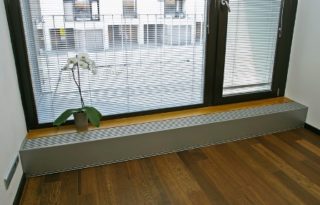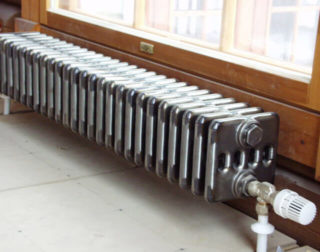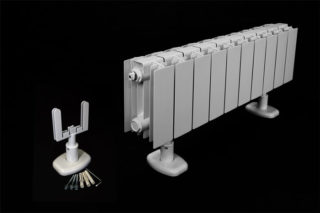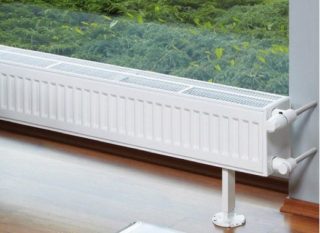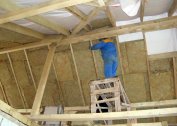For efficient heating of rooms with panoramic glazing or wide enough “French” windows, a non-standard solution will be required. One of the possible options is to install low batteries, which guarantee high-quality heating of the apartment, and also prevent the spread of cold and icy glass. This approach to solving the problem is the only true one, except when thermal curtains are used. Familiarity with the design features of these devices, as well as their advantages and disadvantages, will help in choosing the right type of radiator for panoramic windows.
Design features
The floor type of heaters is presented on the domestic market with a rather modest assortment, since they are not in high demand. They are used only in special cases associated with the presence in the premises of panoramic windows. The design of radiators of this class differs from standard designs in the arrangement of the fins on the case, as well as in their appearance and size.
The minimum dimensions of a type specimen are half a meter in length, 0.1 in depth and 0.2 meters in height. Their maximum sizes in some models can reach 600x230x50 mm, respectively. In addition, the design features of individual samples of low radiators for panoramic windows are associated with the materials used in their manufacture.
Purpose of low floor batteries
Outdoor appliances are in demand in cases where the installation of conventional or “classic” batteries is unacceptable. This applies to apartments with panoramic windows, in which the installation of high radiators spoils the appearance of the rooms. Most often, this manifests itself as a violation of the proportions of spatial forms, accompanied by the following undesirable phenomena:
- high batteries partially close the internal view (even provided that their center distance does not exceed 350 mm);
- with any installation method, they look not very attractive in the window-sill;
- they spoil the view of the panoramic facades from the side of the street, because the part of the batteries protruding above the lines of the windows does not look at all aesthetically pleasing.
Low heating radiators for panoramic windows are distinguished by their miniature size - together with the support legs, their height rarely exceeds 150-200 mm.
To connect low batteries, a pipe eyeliner is selected that corresponds to their intended purpose - do not clutter the facade of the windows. In this case, it will be more convenient to bring the heating pipes directly from the side walls or directly from the floor.
Advantages and disadvantages
The declared advantages of low heatsinks in horizontal design are determined by the already considered features of their application. They are manifested in the following:
- small sizes comparable to the dimensions of their skirting counterparts;
- high heat dissipation, which is the distinguishing characteristic of most models of floor-type radiators, with the exception of cast iron samples;
- attractive appearance, not spoiling the interiors of modern rooms;
- A wide selection of colors, starting with traditional white and ending with a large palette of various shades.
In addition to the gradations of white in some design decisions, a stylization technique is applied like wood or stone.
The pluses of heaters include ease of installation associated with the method of placement in the window-sill. Usually they are installed on the legs that are already on the product body, after which the user will only have to connect the pipes to the lower eyeliner. Individual samples are fixed directly on the floor surface or are built directly into it. With their help, it is possible to heat rooms of considerable size, and also to place them close to the walls without cluttering the living space.
The disadvantages of heating batteries of this class include:
- the limited ways of laying pipes - the need to be embedded in a wall or floor;
- the possibility of using only one heating method - convection;
- the difficulty of selecting and acquiring a model suitable for specific operating conditions.
The disadvantage of the products is the relatively high cost declared by the manufacturer. It significantly exceeds the same indicator for samples of classic batteries.
Materials used
By the type of material used in the manufacture, radiators for French windows are divided into the following types:
- Cast iron batteries obtained by casting and representing a continuous heating section.
- Steel structures assembled from individual plates in combination with a tube base.
- Cast or extruded aluminum radiators.
- Bimetallic products, the manufacture of which uses two different in structure and characteristics of the metal.
Cast iron refers to brittle materials, which limits the allowable water pressure inside the battery sections. In addition, due to the rough surface, various contaminants accumulate on their inner planes, which reduce the effect of heat transfer. On the other hand, cast-iron water radiators retain heat well within the working area and are not subject to the destructive effects of salts dissolved in the coolant.
The design features of steel batteries recruited from individual plates make it possible to increase the level of convection and heat transfer. But they are also the reason for the frequent formation of blockages in the places of mounting plates on the tubes.
The main advantage of an aluminum-based battery is its low weight and the ability to “hold” the increased pressure of the coolant. On the other hand, convection indicators are worse for them than for products made of cast iron and steel. In addition, aluminum is not as durable as other metals, and is not adapted to frequent hydraulic shocks.
Bimetallic radiators, combining two different materials, are usually made of copper tubes with aluminum or steel plates placed on them. The tube base of such a product is able to withstand pressure corresponding to several tens of atmospheres. At the same time, it is not subject to the destructive effect of the coolant, prolonged contact with which for copper is not a problem.
The service life of such batteries is comparable to that of a cast iron product.
Bimetallic type radiators are not too large, however, due to heat losses in the areas where the plates are attached, the heat transfer efficiency is slightly lower than that of their aluminum counterparts.
How to choose a radiator for panoramic windows
Properly choose radiators for panoramic windows in the apartment will help compliance with the following rules:
- Before buying, you should pre-determine the total length, which is measured directly at the installation site. It usually varies from 280 to 600 mm.
- It is important to pay attention to the height of the product, measured in mm.
- You will need to select the type of radiator for the metal used in it, based on the technical specifications given in various sources.
- It is important to determine the type of eyeliner in the apartment and choose the appropriate product sample for it;
- It will not be superfluous to evaluate the design of the models offered by a particular manufacturer, carefully studying the photos presented on the website of the selling company.
Despite the fact that in most cases, trade organizations offer one well-known brand ("Kermi", made in Germany), it will not be amiss to get acquainted with various models from this manufacturer.
Compact radiators for panoramic windows, due to the specifics of their application, are not yet in great demand among Russian consumers. However, given the continuous improvement of the living conditions of a modern person, they are considered promising products that attract the attention of users who care about comfort.
